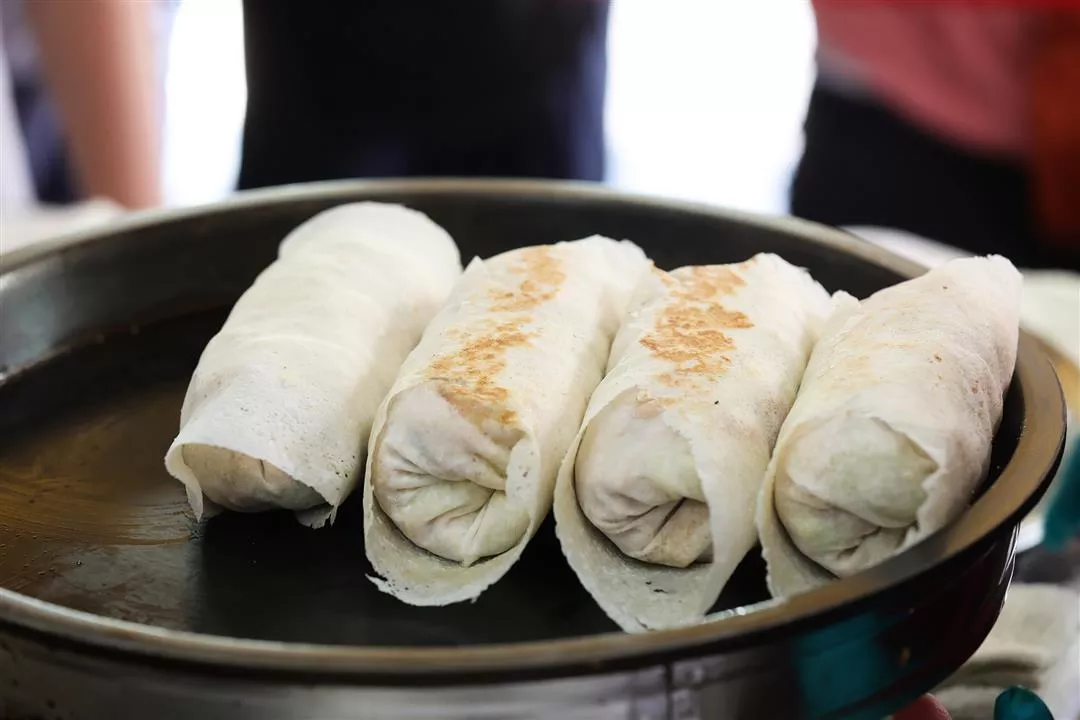Peanut Powder? Lima Beans? Sprout Noodles?
What’s in Your Family’s Popiah?
Esther Tseng / photos by Jimmy Lin / tr. by Scott Williams
June 2024

“On a spring day, slender vegetables on a spring plate / Bring to mind the plums blossoming in the two capitals.”—Du Fu, The First Day of Spring
“Popiah are like a non-verbal lineage documenting the secrets of your life. No need to ask a fortune teller who you are or where you’re from. A bite of your popiah reveals it all.” —Chen Ching-yi, Oh! So That’s Taiwanese Flavor!
You can likely tell where a Taiwanese person is from by what their family rolls into their popiah. Someone who doesn’t eat popiah at home is unlikely to be of Southern Min descent. And ethnic Chinese from Malaysia and Singapore can dive straight into these conversations about ancestry because they eat popiah, too!
Cai Shao-en, a Singaporean visitor to Taiwan, queues up early in the morning for popiah from Lin Linang Bing, a popiah stand in Taipei’s Yongle Market. Declaring it delicious, Cai says that while you can get popiah in Singapore, they are made without the pork and fish floss found in Taiwanese versions, in deference to the beliefs of local Malays, who are mostly Muslim.
Mapping migrations
Taiwanese food writer Chen Ching-yi, who has conducted surveys in China and across Southeast Asia, says that popiah consumption tracks migration and its name varies accordingly. In the Southern Min spoken in the Chinese city of Zhangzhou and in much of Taiwan, popiah are known as lūn-piánn (runbing in Mandarin). In Malaysia, Singapore, and Xiamen, China, the source of much of the ethnic Chinese migration to Southeast Asia, they are called po̍h-piánn (Mandarin bobing), the origin of the English form popiah. On Kinmen, they are known as tshit-piánn (shibing). In Quanzhou, China, where popiah include nearly a whole cafeteria’s worth of ingredients, residents classify them as a dish rather than just a snack, and Indonesia has gone so far as to designate its ubiquitous lumpia (runbing) as an “intangible cultural asset.”
“Indonesia’s history as a Dutch colony brought popiah all the way to the Netherlands, where they are called loempia and are a popular snack,” explains Chen. “That’s probably as far West as they have traveled.”

Food writer Chen Ching-yi says popiah express a family’s distinctive history and character.


Large quantities of curried cabbage and bean sprouts are the signature ingredients in Lin Linang Bing’s popiah.
Varied ingredients
Chen says that if you peek inside a popiah, you’ll see that every ingredient is essential. She argues further that few people recognize the logic underlying how you wrap one. Peanut powder is the base, there to keep the vegetables from making the skin soggy. Meat, dried tofu, egg shreds and julienned carrots are the main ingredients. Celery, cilantro, garlic chives, and scallions (whites or greens) deliver stronger flavors for the finishing touch.
Speaking to the connection between popiah ingredients and place, Chen tells us that lima beans in your popiah suggest that your family is from Tainan, and that crab, prawns and mullet roe are also common fillings among those who call that city home.
In contrast, farming regions like the Jianan Plain often include oil noodles or sprout noodles in their popiah. Yang Caisheng, the third-generation owner of Taichung’s Yang Qinghua Popiah, says that he’s seen customers from rural Chiayi go buy fried noodles from another shop to add to the popiah they’ve just bought from his.




Local ingredients
Migrations and differences in local products have given rise to different versions of popiah. Chen says that the Taiwanese practice of sprinkling nori inside popiah grew out of the Xiamen practice of adding branched string lettuce. Japan’s influence during its rule over Taiwan also increased local acceptance of nori.
Some areas have very distinctive takes on popiah. For example, Chen says that in Quanzhou, the filling is nearly half carrot! In Xiamen, cooks add snow peas to give popiah more crunch—fussier chefs slice them into very fine strips—and dress up the modern version with fried breaded oysters.
In Fuzhou, popiah include red-vinasse pork and so many beansprouts that these are considered the main ingredient.
Taiwanese popiah contain deep-fried egg floss, which reduces the astringency of veggie-loaded rolls. Chen, who just published her second book on Malaysian cuisine this year, says that ethnic Chinese in Malacca add pork crackling to their popiah for the same reason.
“I think Penang’s nyonya pie tee are especially interesting,” says Chen. According to Malaysian author Lin Jin-cheng, nyonya pie tee are a variation on popiah.
Chen adds that Indonesian popiah—also known as lumpia—are distinguished by the garnishes served with them—sweet sauce, small chilies, pearl onions, minced garlic—and that Javanese are especially fond of sweet flavors.

Tainan’s Kintoku Spring Rolls allows patrons to customize the amounts of sugar and other flavorings in their popiah.

Kintoku’s spring rolls have two crispy “wings” that take the flavor to another level.
A meal for the whole family
Part of the point of popiah is getting one’s family together. On Tomb Sweeping Day, the whole family works together to prepare the ingredients used to make popiah and then fills and wraps the rolls. Many of us have childhood memories of folding the warm, just purchased wrappers into a fan shape.
Chen laments that many people no longer wrap and eat popiah because there’s no one to do it with. This is costing them an opportunity to make memories of family gatherings and causing them to miss out on the particular feelings associated with this food.
Popiah embody not only your local culinary terrain, but also your connections to those near and dear to you. As Chen has written, “Popiah are a non-verbal lineage,” an expression of the particular character of your family.

Max (right), a visitor from Germany, says: “Kintoku serves the biggest spring rolls I’ve ever had.”
@List.jpg?w=522&h=410&mode=crop&format=webp&quality=80)



@List.jpg?w=522&h=410&mode=crop&format=webp&quality=80)


